Japchae is a classic Korean Glass Noodle dish that is served as a side dish or appetizer. Mild in flavor, this is a great first dish to try if you never had Korean food before. This Japchae recipe is traditional and authentic – exactly how my family made it for years, so Enjoy!
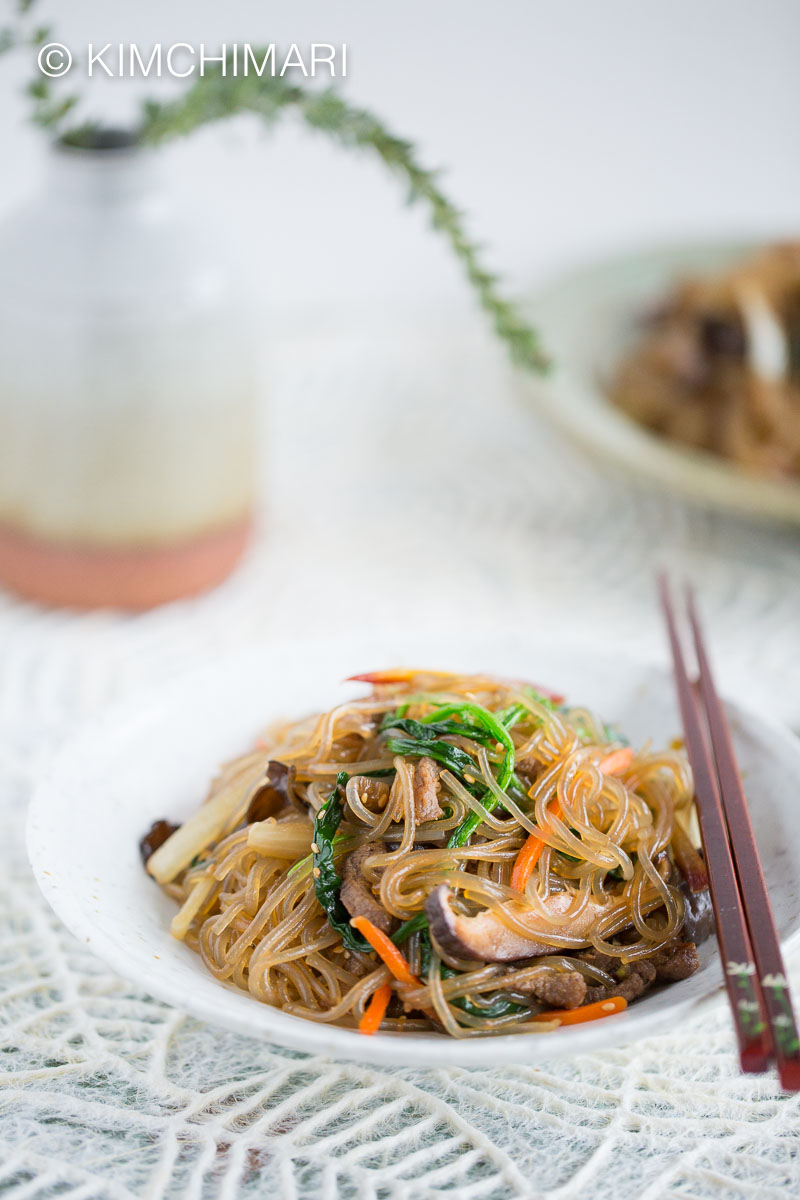
Japchae is a very popular Korean glass noodle side dish that’s made with vegetables and also sometimes meat. If you have ever been to a Korean restaurant, chances are you probably have had Japchae(잡채). And if side dish was the only way you had it (as opposed to an a la carte item)- then I’m afraid you probably had a very poorly made japchae.
It sometimes makes me mad when I see restaurants serve this most delicious Korean glass noodle dish as a side dish that’s missing the authentic ingredients and flavor. Probably it’s 98% noodles and then maybe some little specks of vegetables once in a blue moon and no evidence of beef anywhere. Either that or it’s been reheated so many times that it has just morphed into something else.
About Japchae 잡채
Jap(잡雜) means to mix and Chae(채菜) means ‘vegetables’. Historical records go back as far as 17th century Joseon Dynasty when it was first served to the King Kwanghaekun. Interestingly, there were no noodles in the earlier versions and the glass noodles only appeared in this dish in 1919 when a Dangmyeon 당면 (Glass Noodles/Potato Starch Noodles) factory first appeared in the Hwanghae region of Northern Korea.
My Japchae (ChopChae) Story 😂
There’s a story that I’m reminded of every time I try to explain Japchae to someone.
You see.. my father was a diplomat and he had a very good friend who was the US Ambassador (Mr. Walker) to Korea in the early 80’s. We had dinner together at a Korean restaurant in DC one time (I think it was actually Wooraeok), and the ambassador said that he loved Japchae (or as he called it ‘ChopChoi’) and wanted to order it.
And then he said “Do you know how I memorized the name of this dish?? It’s the “execute” = “chop” Mr. Chae (or choi) dish!!” HAHAHA..I thought it was a bit bizarre but also hilarious and very ingenious of him…😂🤣and so the story has always stuck with me ever since. BTW, the ‘chop’ 잡 can be pronounced as somewhere between Job and Chop.
Well, I hope this will help you remember the name a little easier next time! 😍
What makes an Authentic Japchae
The Japchae recipe I introduce here is the way my mom used to make at home when I was little – for the Seollal or Chuseok holidays and big parties. I know there are different ways of making Japchae but the authentic and traditional way to make Japchae is to saute and season all ingredients separately (I know it’s kind of a pain) and then mix it all together at the end.
Because this can be quite time-consuming, many recipes you see today may tell you to saute all the ingredients all together at the same time. And in my opinion, unless done right (which I actually have found a way to make it right – see my One Pan Japchae recipe for quicker version), it usually produces a mediocre one where everything is soggy, mushy and wet.
Also in terms of ingredients, spinach, beef, carrots, onions and wood ear mushrooms are classic and authentic ingredients that are usually used to make this dish. The authentic recipe for Japchae I have below takes a bit of work and that’s probably why it’s known to be a Janchi Eumshik(잔치음식) = party food. But I think it’s well worth the effort. One simply could not have a true Janchi (party) without executing Mr. Chae!😂🤣
What is Dangmyeon (Korean Glass Noodles) and what brand should I buy?
Dangmyeon is a dried noodle made from 100% sweet potato so it’s a great gluten-free food. It is quite chewy and is also low in calories (90 calories per 1 oz). I have not found a lot of difference between the brands so just buy a reputable brand and that should be fine.
Japchae FAQ
- Is Japchae served HOT or COLD?
- Japchae is best served at room temperature but t can be served warm too. Japchae can be stored at cool room temperature for up to a day.
- Is Japchae low carb?
- That’s kind of hard to answer simply. Dangmyeon (Glass Noodles) itself is pretty high in carb as it is made from sweet potato starch. But all the other ingredients (vegetables and beef) are almost zero carb. So my nutrition facts of my recipe say the Japchae carb is around 23 g per serving which is not high but not low either. You can make it low carb by reducing the amount of noodles and adding more vegetables and meat. And using less sugar or use a sugar substitute.
- How do you reheat Japchae?
- Reheat in a non-stick frying pan over medium-low heat, stirring often. You can also microwave but I prefer the pan method.
- How long does Japchae keep in the fridge?
- It can be stored in the fridge up to a few days or can also be frozen.
- How should I store Japchae?
- Japchae will spoil if left at room temp longer than half a day in warmer temperatures (summer) so store in fridge right away.
My Tips for Making Perfect Japchae
- Seasoning Japchae – Glass noodles absorbs the seasoning well which means it may taste bland after some time after you season it. So it is best to taste 2-3 times after it is made to make sure it tastes good at time of serving. So taste it right after, maybe another time after letting it sit for an hour and then another time right before serving. Adding little more sugar, soy sauce and sesame oil if you feel like it is missing something.
- Spinach – it is best to use young tender spinach that you buy from Asian or Korean markets. Do NOT overcook the spinach when you blanch. The texture should be chewy.
- Mushrooms – Substitute fresh oyster mushrooms for shitake mushrooms. Wood ear mushrooms are OPTIONAL but adds a great crunch so try to get some!
- Variations or Substitutions
- Pork or imitation crab meat in lieu of beef.
- green or red bell peppers (julienned), Chinese chives, green onions or even some green chili peppers can be substituted for spinach
- Egg Jidan (thin pan-fried crepe-like egg) can be added on top as a garnish.
- Vegan – just omit beef, see my One-Pan Japchae recipe below.
- Gluten Free – glass noodles are naturally gluten-free. To make it 100% gluten-free Japchae, just make sure to use a GF soy sauce like Tamari soy sauce.
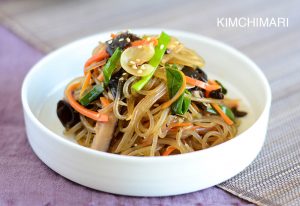
UPDATE – Here’s my one-pan Japchae recipe that I uploaded in 2016, if you want to try it. I simplified the recipe without sacrificing the flavor!
Japchae (Korean Glass Noodles) Recipe
Servings: 6 Prep Time: 30 min Cooking Time: 30 min Difficulty: Medium
Step-by-Step Directions
- BEEF
- Cut beef into thin strips, against the grain. If you want an easy way out, you can also use bulgogi meat cut into smaller pieces.
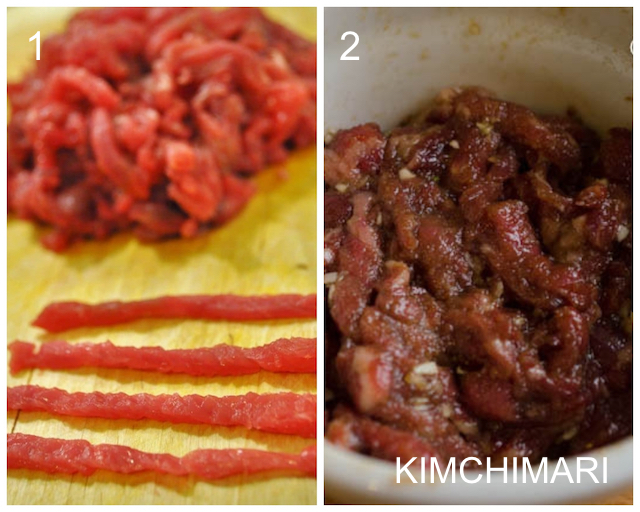
Marinating Beef For Japchae - Mix the beef marinade in a bowl big enough to hold the beef. Add the beef, massage it with your hands and let it sit for a few minutes while you prepare the vegetables. I used garlic powder here because the garlic flavor doesn’t need to be very strong in this dish but you can certainly use fresh garlic if you prefer.
- Cut beef into thin strips, against the grain. If you want an easy way out, you can also use bulgogi meat cut into smaller pieces.
- GLASS NOODLES (Dangmyeon)
- Boil 8-10 C of water in a pot and boil the dangmyeon (glass noodles) according to package instructions (usually 6-8 min) or until the noodles become clear and is soft all the way to the center of the noodle. More water is better than too little since the glass noodles soak quite a bit of water.
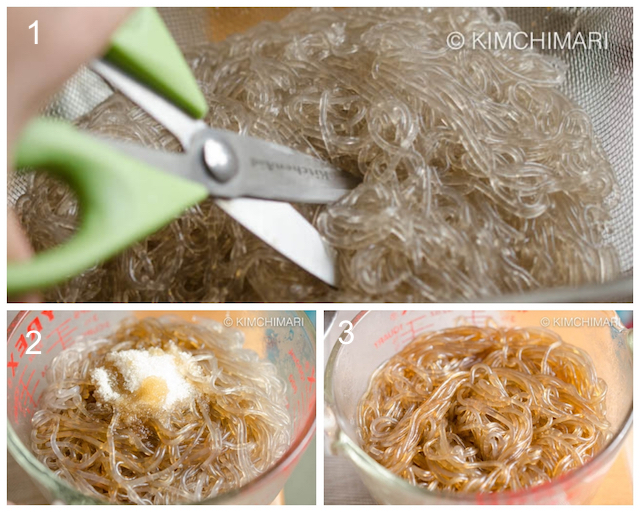
Glass Noodles (Dangmyeon) for Japchae - Once the noodles are cooked, drain. While noodles are still warm, season with soy sauce, sugar and sesame oil.
- Cut noodles with scissors a few times so they are easier to eat. Coating the noodles with oil will keep the noodles from sticking together.
- Boil 8-10 C of water in a pot and boil the dangmyeon (glass noodles) according to package instructions (usually 6-8 min) or until the noodles become clear and is soft all the way to the center of the noodle. More water is better than too little since the glass noodles soak quite a bit of water.
- SPINACH
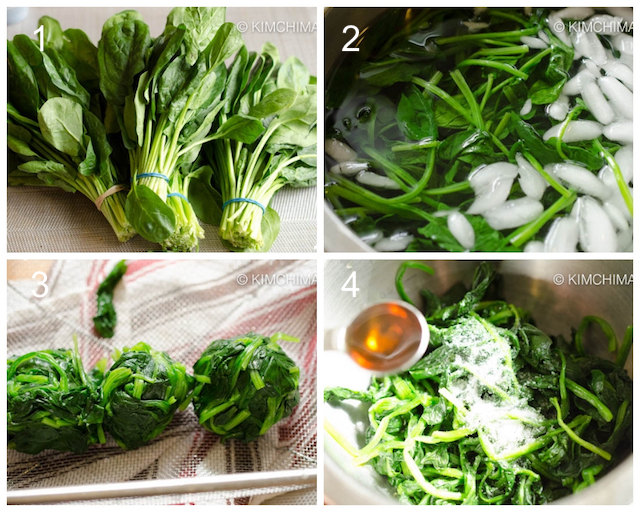
How to cook spinach for Japchae - Wash spinach. Boil another pot of salted water (6 C or so + 1 tsp salt) and quickly blanch them. Do not over cook the spinach – probably no more than 40 seconds. Spinach should be still a bit chewy and not too mushy.
- Shock the cooked spinach in cold or ice water to stop the cooking process.
- Drain the water and squeeze out any excess water from the spinach by squeezing them gently between your hands, forming a ball.
- Season blanched spinach with some salt and sesame oil. Set aside.
- MUSHROOMS
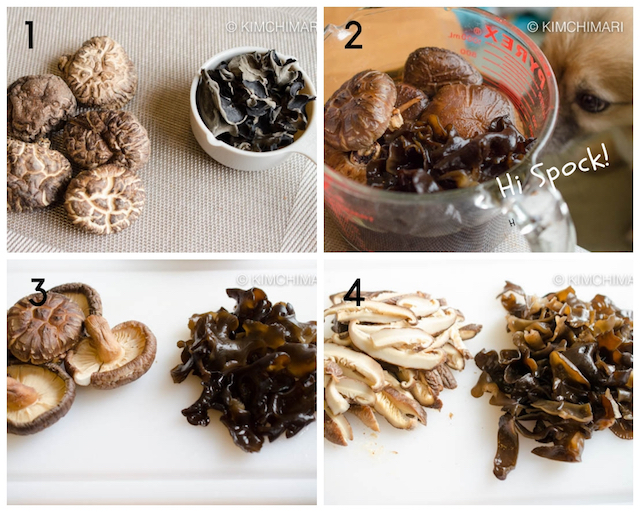
Shitake Mushrooms for Japchae - Soak dried shitake mushrooms (left) and wood ear mushrooms (on the right in top left pic #1).
- Rehydrate mushrooms in warm water until they are fully soft (about 20 min). To speed things up, soak them in hot water.
- Clean soaked mushrooms under water. Sometimes dirt/sand are buried in the mushroom to make sure all the dirt is washed off. You can also cut off the ends that have the dirt.
- Cut shitake mushrooms into thin strips. Cut wood ear mushrooms into rough wider strips. Set aside.
- CARROTS/ONIONS

onions and carrots for Japchae - Julienne carrots and onions and set aside.
- SAUTE INGREDIENTS – Saute each of the ingredients separately and let them cool. You can save yourself the trouble of washing pans in between by using one frying pan and sauteing ingredients one by one in the following order: onions -> carrots -> mushrooms -> beef. Just wipe off any excess oil and crumbs with a paper towel after cooking each ingredient and you should be good to go.
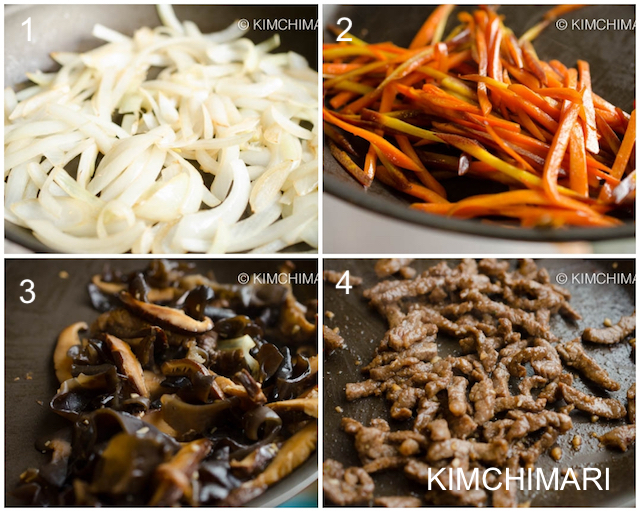
Japchae Ingredients Sauteeing in pan - Add 1 T oil in frying pan on medium heat. Add onions and sprinkle a pinch of salt. Saute until onions become transparent but not brown.
- Add 1 T oil in frying pan on medium heat. Add carrots and a pinch of salt. Saute carrots until they are soft and tender
- Add 1 T oil in frying pan on medium heat. Add mushrooms and a pinch of salt. Saute for 3 mins or so and the mushrooms should be done
- Add 1/2 T oil in frying pan on medium-high heat. Saute the beef until they are fully cooked. If there are any extra juices in the pan, cook a little more until it’s evaporated.
- Transfer each of the onions, carrots, mushrooms and beef to a plate and let them cool.
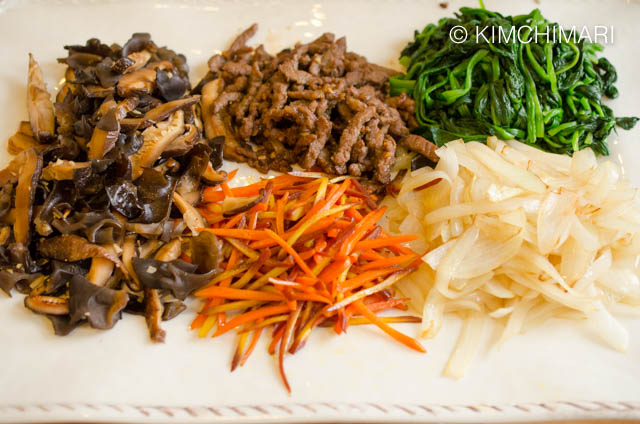
Japchae Ingredients ready for MIxing - It’s time to put everything together! Add all the cooked vegetables and beef to the noodles and mix them all together.
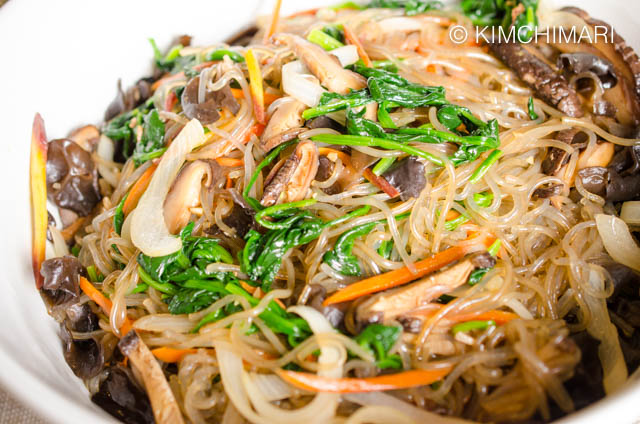
Japchae Mixed and Finished
Sprinkle some toasted sesame seeds. Taste some noodles with the vegetables and the beef. Adjust seasoning with more soy sauce and sugar as needed. Unless you like things really bland, it will taste better if you add more soy sauce, sugar and a dash of sesame oil as the final finishing touch. (I added about 3 Tbs soy sauce, 1 Tbs sugar and 1 Tbs sesame oil to a 450g of glass noodles.)
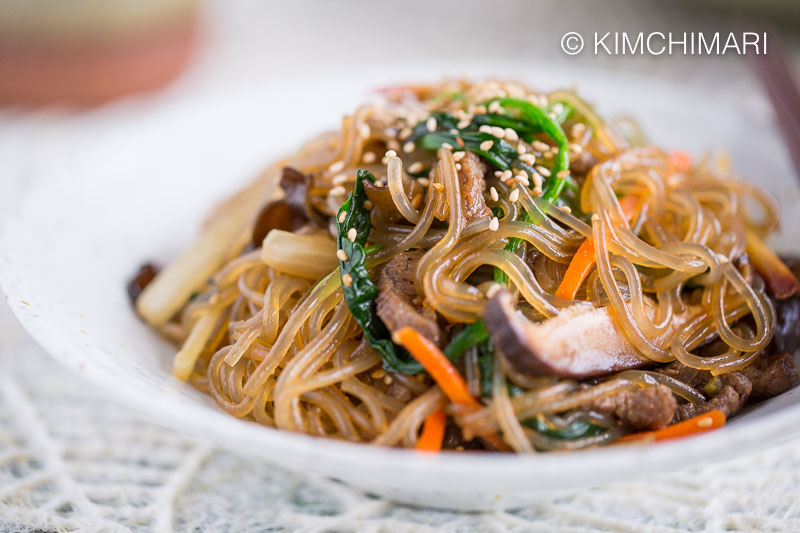
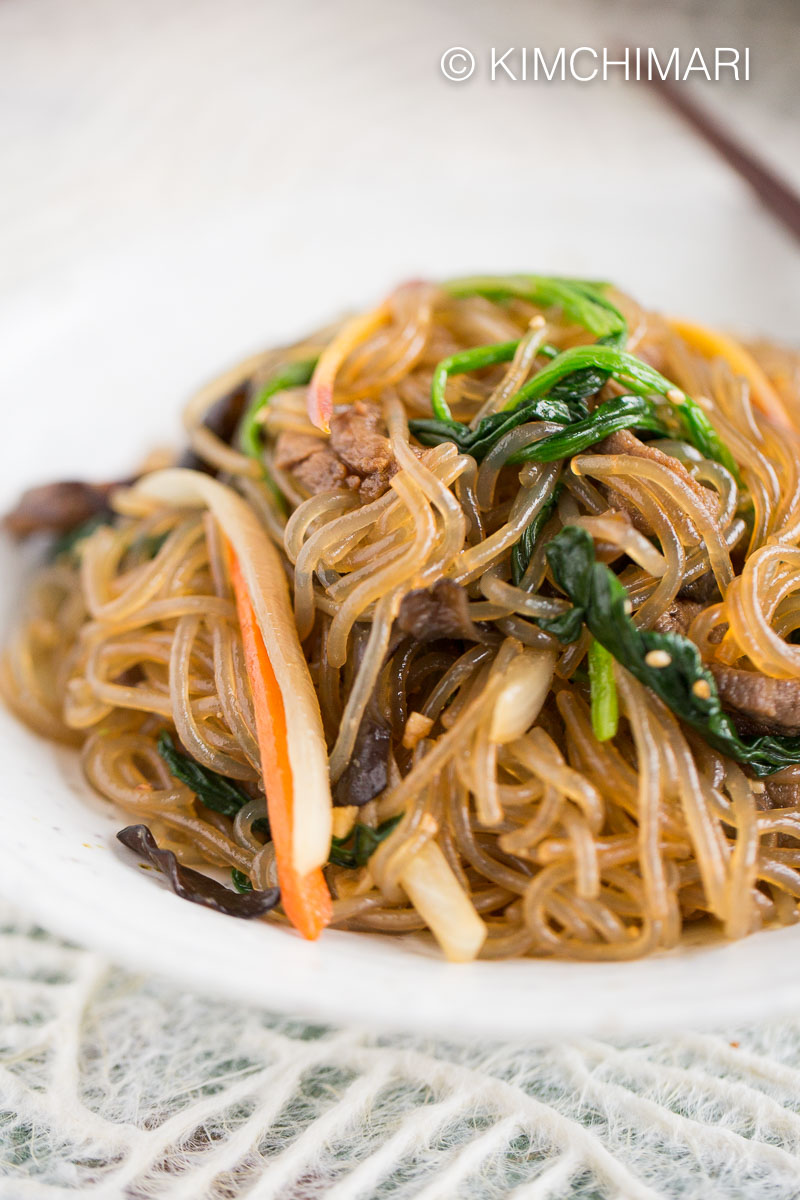
That’s it! Enjoy it with some rice and other main dishes. Since this Japchae/Chapchae is very mildly flavored, it goes well with a lot of things but it goes particularly well with other party dishes like
And because it is a lot of work, when I make it for our dinners, I usually have this as our main dish with some rice and maybe some soup or jjigae.
If you have tried my authentic Japchae or any other recipe on my blog then please don’t forget to rate the recipe (top right of the recipe card) and leave me a comment to let me know how you like it! I’d LOVE to hear from you! 😍
You can also FOLLOW ME on FACEBOOK, PINTEREST and INSTAGRAM or join my FACEBOOK GROUP to see other Korean recipes to ask and share everything about Korean food with others just like you!
Enjoy~ ❤
JinJoo
Japchae - Korean Glass Noodles
Ingredients
- 3 1/2 Tbsp canola oil or vegetable oil
- 1/2 carrot , julienned (approx 1 C)
- 1/2 onion , sliced thin
- 1 bunch spinach
- 8 oz Korean glass noodles or cellophane noodles (당면 Dangmyeon) 8 oz = approx. 1/2 of 450g/15.8 oz big bag
- 1/4 cup dried wood ear mushroom (목이버섯 mokibeoseot) OPTIONAL
- 3 shitake mushrooms dried
Beef marinade
- 5 oz beef (stew meat) , cut into thin strips
- 2 tsp soy sauce
- 2 tsp sugar
- 1 tsp sesame oil
- 1 tsp rice cooking wine
- 0.5 tsp garlic powder (or 1/4 tsp fresh chopped garlic)
Seasoning for the Dangmyeon (Glass Noodles) - 8 oz (1/2 large bag) = 4 cup cooked
- 2 Tbsp soy sauce
- 1 Tbsp sugar
- 1.5 Tbsp sesame oil
Finishing seasoning
- 1.5 Tbsp soy sauce Jin Ganjang
- 2 tsp sugar
- 2 tsp sesame oil
- 1 Tbsp sesame seeds
Instructions
BEEF
- Cut 5 oz beef (stew meat) into thin strips, against the grain.
- Make beef marinade in a large bowl by adding 2 tsp soy sauce, 2 tsp sugar, 1 tsp sesame oil, 1 tsp rice cooking wine, 0.5 tsp garlic powder. Add the beef, mix and let it sit for a few minutes.
Glass Noodles
- Boil 8-10 C of water in a pot and cook the 8 oz Korean glass noodles or cellophane noodles according to package instructions(e.g.6 min) or until the noodles become clear and is soft all the way to the center of the noodle.
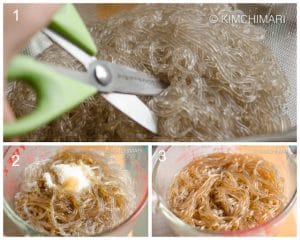
- Drain cooked noodles. While noodles are still warm, season with 2 Tbsp soy sauce, 1 Tbsp sugar, 1.5 Tbsp sesame oil. Cut the noodles with scissors a few times.
Spinach
- Boil salted water (6 C water + 1 tsp salt). Quickly blanch 1 bunch spinach in boiling salted water. Do not cook the spinach more than 40 seconds. Spinach should be still a bit chewy and not too mushy.
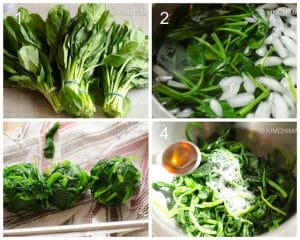
- Shock cooked spinach in cold or ice water, drain and squeeze gently to remove excess water.
- Season the blanched spinach with some salt (1/2 tsp) and sesame oil (1 tsp). Set aside.
Shitake and Wood Ear Mushrooms (Mogi Beoseot 목이버섯)
- If using dried 3 shitake mushrooms and/or 1/4 cup dried wood ear mushroom: soak them in some warm water for 10-20 min or so until they are fully hydrated.
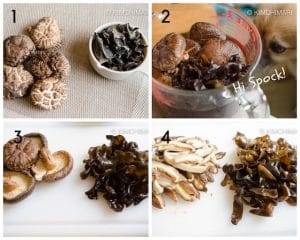
- Clean the fresh or rehydrated mushrooms by rubbing each mushroom under cold running water.
- Cut shitake mushrooms into thin strips. Cut wood ear mushrooms into wide strips. Set aside.
Carrots and Onions
- Julienne 1/2 carrot and 1/2 onion and set aside.
Saute Ingredients
- Saute each of the ingredients separately and let them cool. Saute ingredients one by one in the following order: onions -> carrots -> mushrooms -> beef. Just wipe off any excess oil and crumbs with a paper towel after cooking each ingredient and you should be good to go!
- - Add 1 T oil in frying pan on medium heat. Add onions and sprinkle a pinch of salt. Saute until onions become transparent but not brown. Remove
- - Add 1 T oil in same pan. Add carrots and a pinch of salt. Saute carrots until they are soft and tender. remove.
- - Add 1 T oil. Add mushrooms and a pinch of salt. Saute for 3 mins or so and the mushrooms should be done.
- - Add 1/2 T oil in frying pan on medium-high heat. Saute the beef until they are fully cooked. If there are any extra juices in the pan, cook a little more until it's evaporated.
- Transfer each of the onions, carrots, mushrooms and beef to a plate and let them cool.
Mix Ingredients
- Add all the cooked vegetables and beef to the noodles and mix them altogether. Sprinkle some toasted 1 Tbsp sesame seeds. Adjust the seasoning with more soy sauce and sugar as needed.
- Unless you like things really bland, it will taste much better if you add more 1.5 Tbsp soy sauce, (1~2 Tbsp), 2 tsp sugar and 2 tsp sesame oil as the final finishing touch. Amount is based on 200g dangmyeon.
Tips & Notes:
- Seasoning Japchae - Glass noodles may taste bland after some time after you season it. So it is best to taste again afterward. Adding little more sugar, soy sauce and sesame oil if you feel like it is missing something.
- Serving and Storing - Japchae is best served at room temperature but t can be served warm too. Japchae will spoil if left out longer than half a day in warmer temperatures (summer) so store in the fridge right away. It can be stored in the fridge up to a few days or can also be frozen.
- Reheat in a non-stick frying pan over medium-low heat, stirring often.
- Variations or Substitutions
- Pork or imitation crab meat in lieu of beef.
- green bell peppers (julienned), Chinese chives, green onions or even some green chili peppers can be substituted for spinach
- Egg Jidan (thin pan-fried crepe-like egg sheet) can be added on top as a garnish.
- Vegan - just omit beef, see my One-Pan Japchae recipe below.
- Gluten Free - glass noodles are naturally gluten-free. To make it 100% gluten-free Japchae, just make sure to use a GF soy sauce like Tamari soy sauce.
- Substitute fresh oyster mushrooms for wood ear mushrooms. Wood ear mushroom is OPTIONAL although it really does add wonderful crunchy texture.
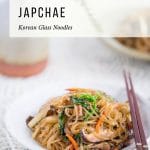
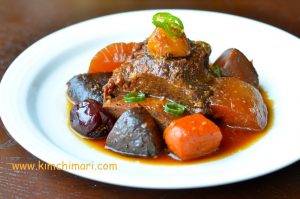
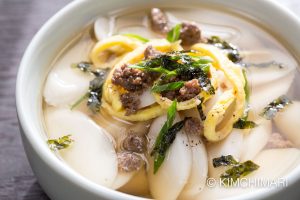
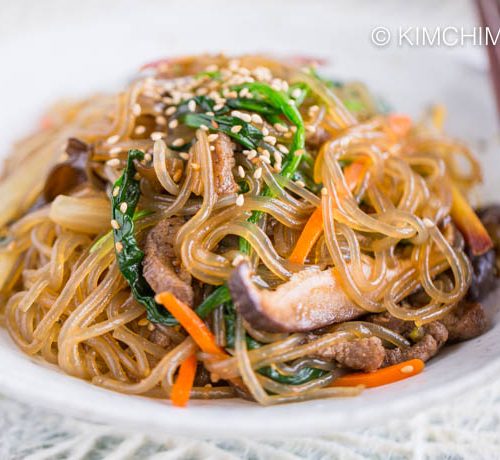
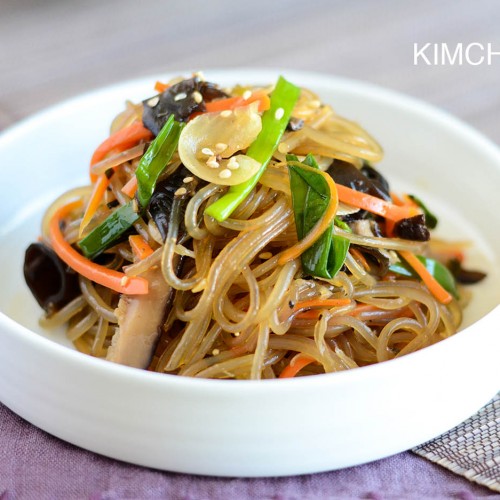
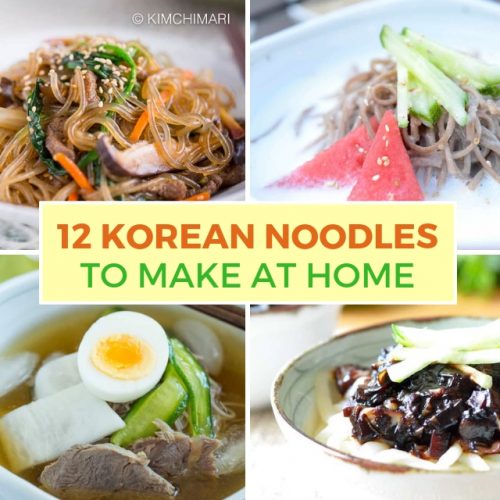
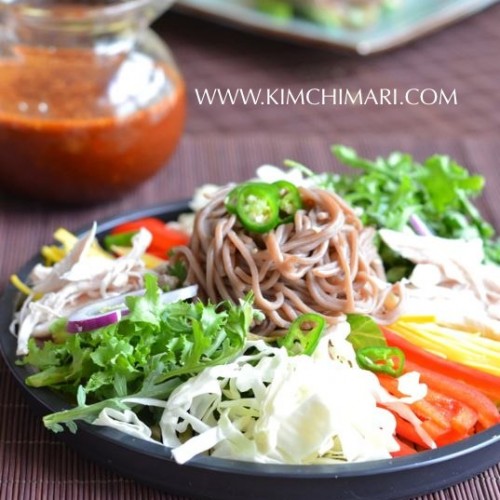
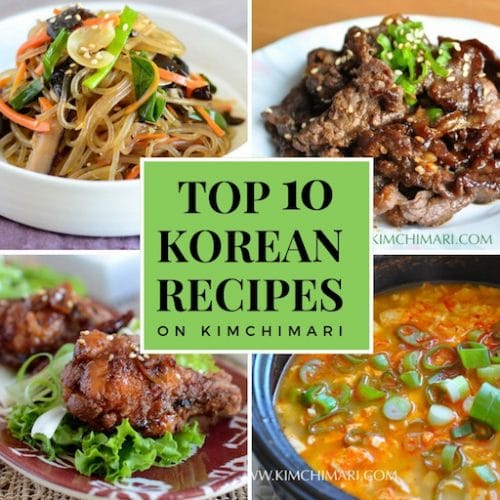
















Really delicious recipe! I made a double batch and used slightly more beef than called for (12 oz of ribeye) as that was the smallest package I could find, as well as a full ounce of dried wood ear mushrooms.
My only problem was when it came time to mix everything together — it was a little tricky to mix the double recipe, even in our largest pasta bowl, without accidentally ejecting some ingredients from the bowl. If I make a double recipe again I will split everything in half and mix in batches.
Also, because I cooked and seasoned the noodles before blanching the spinach and sautéing the vegetables and meat, by the time I was mixing everything together the noodles were somewhat stuck together. I would suggest making the noodles last, mixing everything while the noodles are still hot and not too sticky, and then letting the whole dish cool to room temp for serving…but again, just my suggestion!
I really loved this recipe, and my parents said it was better than the japchae they’ve had in restaurants. Thank you for creating and publishing this recipe, JinJoo 🙂
Wonderful!! Yes, making a lot of Japchae is a bit of a challenge but yup – dividing into portions will help. The noodles can sort of get stuck together when you leave it too long so that’s why I suggest coating with sesame oil first before it’s mixed with other ingredients. Even with the sesame oil, it can still get a little stuck together when it’s time to mix and you can also add some extra sesame oil to unstuck the noodles. Thank you so much for the kind feedback. Glad your family enjoyed it!